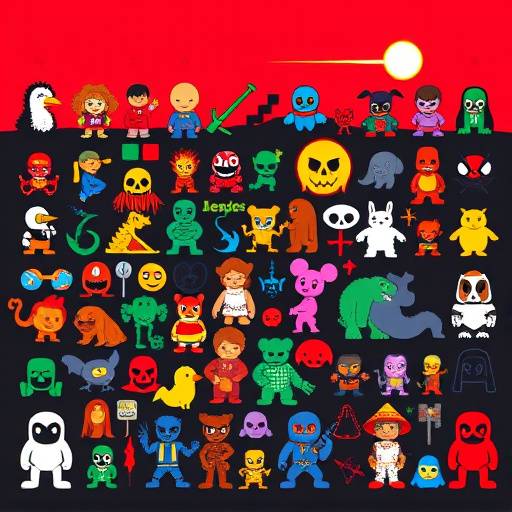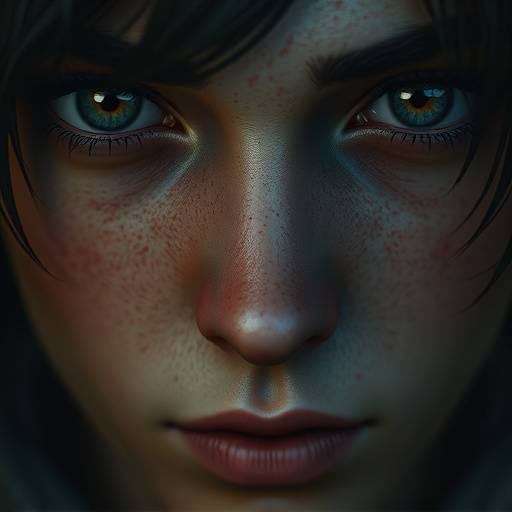The Canvas of Code: A New Era of Visual Storytelling
Video games have transcended their origins as simple interactive diversions to become powerful mediums for artistic expression and profound storytelling. This journey is most vividly reflected in their evolving visual culture. What began as rudimentary pixel art, constrained by technological limitations, has blossomed into breathtakingly detailed worlds capable of eliciting complex human emotions and exploring nuanced narratives. This site, "Pixel to Persona," embarks on an exploration of this transformative artistic evolution. We delve into the fundamental shifts in design philosophy, technological advancements, and creative ambition that have sculpted the visual identity of video games, transforming them into the rich, immersive experiences we know and love today. From the stark, geometric beauty of early arcade titles to the photorealistic, emotionally charged character portrayals of modern blockbusters, the visual language of games has consistently pushed boundaries and redefined what is artistically possible within interactive entertainment.
Our journey will trace the lineage of these visual styles, examining the unique challenges and creative triumphs at each stage. We will celebrate the ingenuity that gave rise to iconic imagery from abstract shapes to detailed characters and explore how these visual innovations have not only enhanced gameplay but also deepened player engagement and emotional connection. Prepare to witness the metamorphosis of digital art within one of the most dynamic and influential entertainment industries in the world. This exploration is not merely about graphics; it's about how visual design has become intrinsically linked to narrative, gameplay mechanics, and the very soul of interactive storytelling.
The Genesis of Geometry: The Charm of Minimalist Game Art
In the nascent days of video games, graphical representation was an exercise in extreme constraint. Developers, working with limited processing power and memory, had to devise visual strategies that were both functional and evocative. This necessity birthed the era of minimalist art. Simple geometric shapes, blocky sprites, and limited color palettes were the building blocks of entire worlds. Yet, within these limitations, a distinct and enduring aesthetic emerged. Titles like Pong , Space Invaders , and Pac-Man relied on the player's imagination to fill in the details, transforming abstract forms into engaging challenges. The vibrant, blocky characters and environments of games like Super Mario Bros. on the NES, or the stark, wireframe worlds of early 3D experiments, showcased a powerful ability to convey atmosphere and gameplay intent with remarkable economy. This art style wasn't just a placeholder; it was a deliberate artistic choice that fostered a sense of wonder and encouraged players to actively participate in constructing the game's reality.
The appeal of this era lies in its purity and directness. The absence of visual clutter allowed the core mechanics of the game to shine. Minimalist art encouraged players to focus on patterns, strategy, and reflexes, creating a unique form of engagement. The iconic sounds and simple animations paired with these visuals formed a cohesive and instantly recognizable experience. The legacy of this period continues to influence modern indie games, which often adopt retro aesthetics as a deliberate artistic statement, proving the timeless appeal of well-executed simplicity. The challenge was to be iconic with the fewest possible pixels, a task that yielded some of the most memorable characters and scenes in gaming history.

The Pursuit of Perfection: The Rise of Hyperrealism
As technology advanced, so did the ambition for visual fidelity. The late 1990s and early 2000s witnessed a significant shift towards realism. Developers began leveraging more powerful hardware to render increasingly detailed environments, complex character models, and lifelike lighting effects. The jump from polygons to more organic shapes, the introduction of texture mapping, and the refinement of animation techniques allowed games to create worlds that felt more tangible and immersive. Titles like Final Fantasy VII , Half-Life , and later Gears of War and The Last of Us became benchmarks, showcasing what was possible when visual artists aimed for photorealism. This era was defined by an obsessive attention to detail, from the intricate textures on armor to the subtle nuances of facial expressions and the environmental details that brought virtual worlds to life.
Hyperrealism in games served multiple purposes. It enhanced immersion by making virtual worlds believable, allowed for more sophisticated storytelling by enabling actors to convey subtle emotions through facial capture, and provided a more grounded and relatable experience for players. The ability to render vast, open landscapes with stunning detail, or to zoom in on a character's weary eyes, opened new avenues for artistic expression. This pursuit of realism also pushed the boundaries of visual effects, leading to innovations in shaders, particle systems, and dynamic lighting that have become standard in modern game development. The goal was often to blur the line between the digital and the real, creating experiences that felt as weighty and believable as the world we inhabit.

Beyond Pixels: The Power of Emotional Realism
While hyperrealism focuses on technical fidelity, emotional realism delves into the art of conveying genuine human experience. Contemporary game development recognizes that true immersion often comes not just from looking real, but from feeling real. This means capturing the subtle, often complex, spectrum of human emotions through character design, animation, voice acting, and narrative. Artists now meticulously craft facial expressions that convey a character's inner turmoil, joy, or sorrow. The subtle slump of shoulders, a hesitant glance, or a flicker of pain in the eyes can communicate volumes, creating a profound connection between player and character. The environments themselves often play a role, reflecting a character's state of mind through weather, lighting, and atmosphere.

Character Nuance
The evolution of character modeling and animation has enabled developers to portray a vast range of human emotions with unprecedented subtlety. From a flicker of doubt to the depths of despair, these visual cues draw players deeper into the narrative and foster empathy.

Environmental Resonance
Game worlds are no longer just backdrops; they are active participants in storytelling. The art direction often uses lighting, weather, and the overall mood of a scene to amplify or reflect the emotional state of the player character or the unfolding narrative.
This focus on emotional realism is transforming video games into potent vehicles for exploring the human condition. Games can now tackle themes of loss, love, betrayal, and redemption with a depth and nuance previously reserved for literature or film. The interactive nature of games allows players to not only witness these emotions but to participate in them, making the experience intensely personal and memorable. This is the pinnacle of visual culture in gaming: when art doesn't just represent reality, but helps us understand our own feelings and connections.
Gazing Ahead: The Future of Visual Culture in Gaming
The relentless pace of technological innovation and artistic exploration suggests an exciting future for visual culture in video games. We are already witnessing the burgeoning potential of technologies like real-time ray tracing, which offers unprecedented realism in lighting, reflections, and shadows, creating environments that are virtually indistinguishable from reality. The integration of artificial intelligence is poised to revolutionize character animation, allowing for more dynamic and contextually aware performances, and even procedural content generation that can create vast, ever-evolving worlds.
Virtual Reality (VR) and Augmented Reality (AR) are also pushing the boundaries of what it means to be visually immersed, placing players directly within game worlds and blurring the lines between physical and digital experiences. As hardware becomes more powerful and accessible, we can anticipate increasingly sophisticated graphical capabilities, leading to experiences that are not only visually stunning but also deeply interactive and responsive. The focus will likely continue to shift from pure photorealism towards styles that best serve the narrative and emotional goals of a game, potentially leading to entirely new artistic movements within the medium.
Furthermore, the democratization of game development tools means that a wider range of artistic visions can be realized. This will likely lead to greater diversity in visual styles, with indie developers continuing to innovate and challenge the status quo. We might see more integration of hand-drawn aesthetics, painterly styles, or even entirely new forms of visual expression that we can't yet imagine. The future promises a landscape where visual artistry in games is more diverse, emotionally resonant, and technologically advanced than ever before, offering players experiences that are not only entertaining but also artistically profound and deeply personal.
| Technology/Concept | Potential Impact | Key Features |
|---|---|---|
| Real-Time Ray Tracing | Unprecedented lighting, shadow, and reflection realism. | Physically accurate light simulation, dynamic global illumination. |
| AI-Driven Animation | More natural, responsive, and varied character movements. | Procedural animation generation, context-aware motion blending. |
| VR/AR Integration | Deeper immersion and new forms of interactive visual experiences. | Full sensory engagement, seamless blending of digital and physical worlds. |
| Advanced Procedural Generation | Massive, dynamic, and infinitely explorable game worlds. | Algorithmic world creation, adaptive environments, emergent gameplay. |
| Stylized Realism & New Art Movements | Greater artistic diversity and unique visual identities. | Fusion of different art styles, unique aesthetic choices tailored to narrative. |
Dive Deeper into the Visual Spectrum
This introduction merely scratches the surface of the rich and complex evolution of visual culture in video games. To truly appreciate the artistry, consider exploring the following areas:
- The Art of Simplicity: Delve into the historical context and enduring charm of minimalist game art.
- A Comprehensive Timeline: Trace the major milestones and artistic movements in video game visual history.
- The Heart of the Game: Understand how visual design contributes to emotional depth and player connection.
- Innovations on the Horizon: Explore emerging technologies and artistic directions shaping the future of game visuals.
- Visuals for All: Learn about efforts to make game aesthetics accessible to everyone.